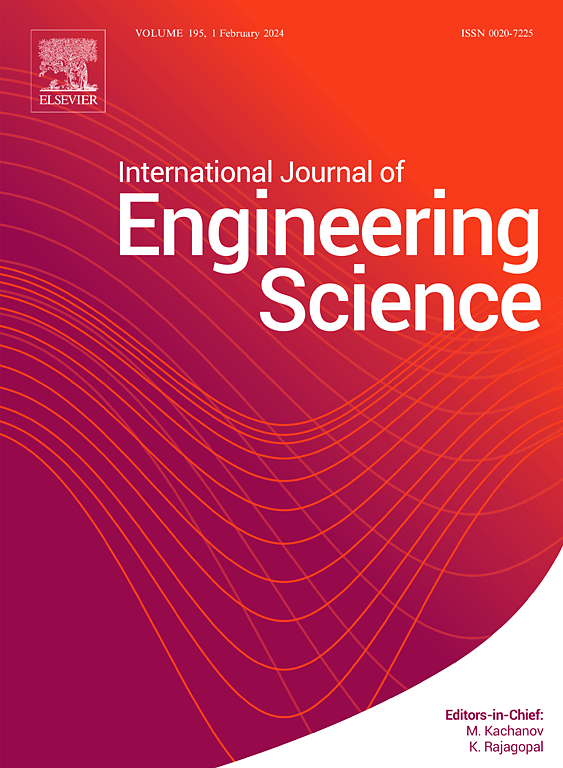Fluid-structure interaction in an arteriovenous fistula: An assumption-related sensitivity analysis
IF 5.7
1区 工程技术
Q1 ENGINEERING, MULTIDISCIPLINARY
International Journal of Engineering Science
Pub Date : 2025-07-24
DOI:10.1016/j.ijengsci.2025.104355
引用次数: 0
Abstract
As the two-way coupled fluid-structure interaction (FSI) methodology has become a widely accepted numerical tool for solving biomedical engineering problems, several questions have arisen regarding the assumptions that must be made when employing FSI. This study focuses on the assumption-related sensitivity FSI analysis of an arteriovenous fistula (AVF) case. AVF is the widely accepted vascular access for hemodialysis, in which highly disturbed non-physiological blood flow is observed and mutual fluid-wall interaction is unavoidable. In the presented high-flow AVF, blood rheology played a minor role since the used Newtonian and non-Newtonian models overlap in the high-shear strain environment. Critical factors that play an important role in FSI simulations were analysed: 1) damping of loose connective tissue (LCT) embedding the AVF vasculature, 2) outlet pressure conditions and dealing with pressurization phase, 3) compliance of LCT, and 4) compliance of blood vessel walls. All of the above-mentioned mechanical factors to some extent affected the temporal quantitative results: lower damping can lead to wall vibrations resulting in biological response; correct procedure coping with the pressurization phase is of very high importance as data concerning the geometry of vasculature are acquired in the prestressed state; the total wall compliance resulting from the elasticity of walls and LCT remains unknown but may be responsible for significant differences in wall extension and temporal progression of hemodynamic parameters. However, when flow parameters are averaged over time, properly performed FSI produces comparable results to the rigid wall approach, which may be alternatively used to analyse hemodynamics in relatively small or stiff vascular models.
动静脉瘘的流固相互作用:假设相关的敏感性分析
随着双向耦合流固耦合(FSI)方法成为解决生物医学工程问题的一种广泛接受的数值工具,在使用FSI时必须做出一些假设,出现了一些问题。本研究的重点是动静脉瘘(AVF)病例的假设相关敏感性FSI分析。AVF是被广泛接受的血液透析血管通路,其中观察到高度紊乱的非生理性血流,并且不可避免地相互作用。在本文提出的高流量AVF中,由于牛顿模型和非牛顿模型在高剪切应变环境中重叠,血液流变学起了次要作用。分析了在FSI模拟中发挥重要作用的关键因素:1)嵌入AVF血管的松散结缔组织(LCT)的阻尼,2)出口压力条件和加压阶段的处理,3)LCT的顺应性,以及4)血管壁的顺应性。上述力学因素都在一定程度上影响了时间定量结果:较低的阻尼会导致壁面振动产生生物反应;处理加压阶段的正确程序非常重要,因为有关血管几何结构的数据是在预应力状态下获得的;由壁和LCT弹性引起的壁总顺应性尚不清楚,但可能是导致壁延伸和血流动力学参数时间进展的显著差异的原因。然而,当流动参数随时间平均时,正确执行的FSI产生的结果与刚性壁方法相当,刚性壁方法可用于分析相对较小或刚性血管模型的血流动力学。
本文章由计算机程序翻译,如有差异,请以英文原文为准。
求助全文
约1分钟内获得全文
求助全文
来源期刊

International Journal of Engineering Science
工程技术-工程:综合
CiteScore
11.80
自引率
16.70%
发文量
86
审稿时长
45 days
期刊介绍:
The International Journal of Engineering Science is not limited to a specific aspect of science and engineering but is instead devoted to a wide range of subfields in the engineering sciences. While it encourages a broad spectrum of contribution in the engineering sciences, its core interest lies in issues concerning material modeling and response. Articles of interdisciplinary nature are particularly welcome.
The primary goal of the new editors is to maintain high quality of publications. There will be a commitment to expediting the time taken for the publication of the papers. The articles that are sent for reviews will have names of the authors deleted with a view towards enhancing the objectivity and fairness of the review process.
Articles that are devoted to the purely mathematical aspects without a discussion of the physical implications of the results or the consideration of specific examples are discouraged. Articles concerning material science should not be limited merely to a description and recording of observations but should contain theoretical or quantitative discussion of the results.
 求助内容:
求助内容: 应助结果提醒方式:
应助结果提醒方式:


